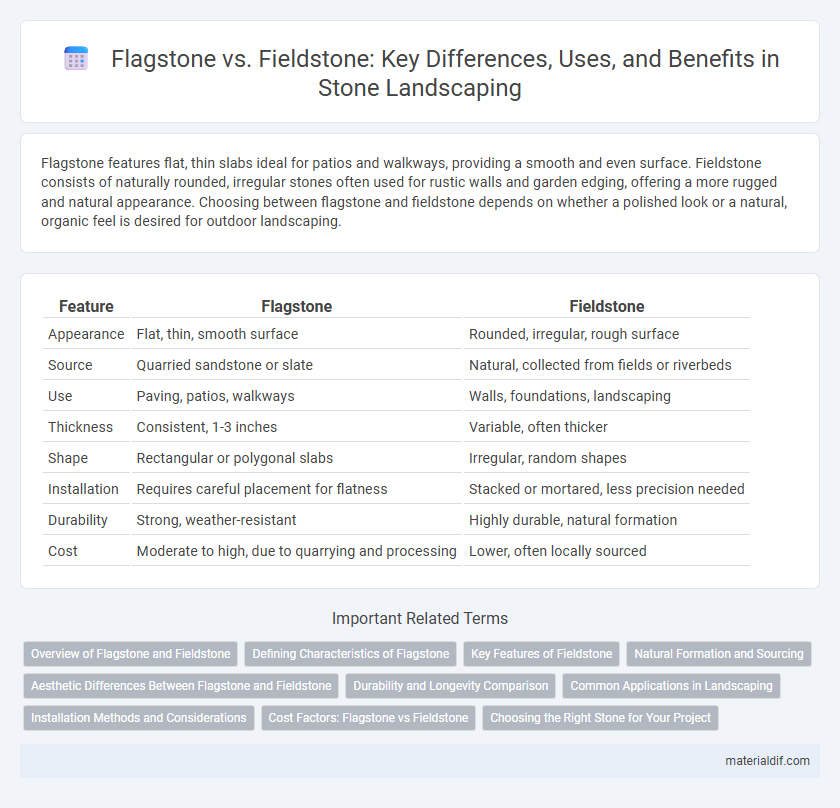Flagstone features flat, thin slabs ideal for patios and walkways, providing a smooth and even surface. Fieldstone consists of naturally rounded, irregular stones often used for rustic walls and garden edging, offering a more rugged and natural appearance. Choosing between flagstone and fieldstone depends on whether a polished look or a natural, organic feel is desired for outdoor landscaping.
Table of Comparison
| Feature | Flagstone | Fieldstone |
|---|---|---|
| Appearance | Flat, thin, smooth surface | Rounded, irregular, rough surface |
| Source | Quarried sandstone or slate | Natural, collected from fields or riverbeds |
| Use | Paving, patios, walkways | Walls, foundations, landscaping |
| Thickness | Consistent, 1-3 inches | Variable, often thicker |
| Shape | Rectangular or polygonal slabs | Irregular, random shapes |
| Installation | Requires careful placement for flatness | Stacked or mortared, less precision needed |
| Durability | Strong, weather-resistant | Highly durable, natural formation |
| Cost | Moderate to high, due to quarrying and processing | Lower, often locally sourced |
Overview of Flagstone and Fieldstone
Flagstone features flat, thin slabs commonly used for paving patios, walkways, and flooring due to its smooth texture and uniform thickness. Fieldstone consists of naturally occurring, irregularly shaped stones often gathered from fields, prized for rustic landscaping, garden walls, and outdoor fireplaces. Both stones offer unique aesthetic qualities and durability, with flagstone providing a polished look and fieldstone delivering a more natural, rugged appearance.
Defining Characteristics of Flagstone
Flagstone is a type of flat, sedimentary rock commonly used for paving and outdoor flooring due to its thin, layered structure and smooth surface. Its defining characteristics include its ability to be easily split into slabs with varying shapes, typically exhibiting earthy tones like red, brown, and gray. Unlike fieldstone, which is irregular and rounded, flagstone offers a more uniform thickness and shape, making it ideal for creating stable, visually appealing patios and walkways.
Key Features of Fieldstone
Fieldstone is a naturally occurring type of stone found on or near the surface of the soil, characterized by its irregular shapes and rough textures, making it ideal for rustic landscaping and garden walls. Its durability and natural weather resistance allow it to withstand outdoor conditions without significant wear or degradation. Unlike cut or shaped stones like flagstone, fieldstone requires minimal processing, preserving its organic, unrefined appearance that enhances the natural aesthetic in construction projects.
Natural Formation and Sourcing
Flagstone forms in thin, flat layers through sedimentary processes, typically sourced from sandstone or shale quarries, making it ideal for paving and patios. Fieldstone originates from glacial deposits or surface stones found naturally scattered in fields, requiring minimal processing. The natural layering of flagstone contrasts with the irregular shapes and textures of fieldstone, influencing their respective applications in landscaping and construction.
Aesthetic Differences Between Flagstone and Fieldstone
Flagstone offers a smooth, flat surface with consistent thickness, creating a clean, formal aesthetic ideal for patios and walkways. Fieldstone displays a natural, irregular shape and texture, providing a rustic, organic appearance perfect for garden walls and natural landscaping. These distinct visual qualities make flagstone suitable for structured designs, while fieldstone enhances more casual, earthy settings.
Durability and Longevity Comparison
Flagstone offers superior durability due to its dense, sedimentary composition, making it highly resistant to cracking and weathering. Fieldstone, composed of naturally occurring stones collected from fields, tends to have variable durability influenced by the stone type and age, often requiring more maintenance over time. Longevity of flagstone typically exceeds that of fieldstone in high-traffic or harsh environmental conditions, ensuring a longer-lasting surface for patios and walkways.
Common Applications in Landscaping
Flagstone is commonly used for patios, walkways, and garden steps due to its flat, uniform surface that provides stable footing and an elegant appearance. Fieldstone, with its irregular shapes and rough texture, is often utilized for natural-looking retaining walls, rustic garden borders, and decorative rock features. Both stones enhance landscaping projects, but flagstone suits structured designs while fieldstone complements more organic, rugged aesthetics.
Installation Methods and Considerations
Flagstone installation requires a stable base of sand or mortar to achieve a flat, even surface ideal for patios and walkways, with careful attention to joint spacing for durability. Fieldstone demands a more flexible installation approach due to its irregular shapes, often set in concrete or dry-laid with gravel, emphasizing proper drainage and fitting to create natural aesthetics. Both materials require skill to balance structural stability and design intent, with flagstone favoring precision and fieldstone allowing organic arrangement.
Cost Factors: Flagstone vs Fieldstone
Flagstone typically incurs higher costs due to its flat, uniform shape and labor-intensive installation process, making it ideal for patios and walkways. Fieldstone is generally more affordable as it is naturally occurring and requires less processing, but its irregular shapes can increase installation complexity. Project size, stone source, and desired finish significantly influence the overall expenses for both flagstone and fieldstone applications.
Choosing the Right Stone for Your Project
Flagstone offers flat, uniformly thin slabs ideal for smooth patios and walkways, providing a polished and elegant look. Fieldstone features irregular, naturally shaped stones perfect for rustic garden walls, edging, and informal landscaping that requires a rugged aesthetic. Your project's design, durability needs, and installation complexity should guide the selection between these two versatile stones.
Flagstone vs Fieldstone Infographic

 materialdif.com
materialdif.com